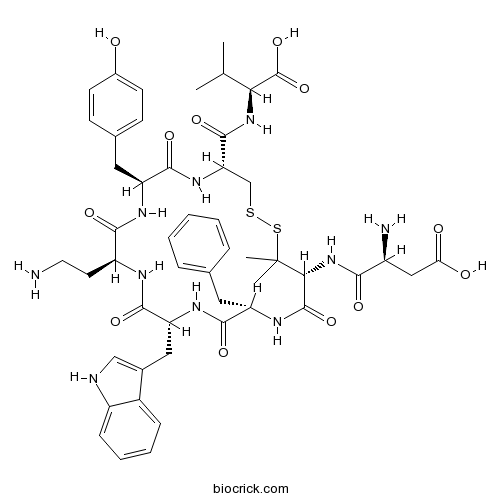UFP 803Urotensin-II (UT) antagonist CAS# 879497-82-2 |

- Laminin (925-933)
Catalog No.:BCC1015
CAS No.:110590-60-8
- Epidermal Growth Factor Receptor Peptide (985-996)
Catalog No.:BCC1014
CAS No.:96249-43-3
Quality Control & MSDS
3D structure
Package In Stock
Number of papers citing our products

| Cas No. | 879497-82-2 | SDF | Download SDF |
| PubChem ID | 56972202 | Appearance | Powder |
| Formula | C50H64N10O12S2 | M.Wt | 1061.24 |
| Type of Compound | N/A | Storage | Desiccate at -20°C |
| Solubility | Soluble in sterile water | ||
| Sequence | DXFWXYCV (Modifications: X-2 = Pen, Trp-4 = D-Trp, X-5 = Dab, Disulfide bridge between 2 - 7) | ||
| Chemical Name | (2S)-2-[[(4R,7S,10S,13R,16S,19R)-19-[[(2S)-2-amino-3-carboxypropanoyl]amino]-10-(2-aminoethyl)-16-benzyl-7-[(4-hydroxyphenyl)methyl]-13-(1H-indol-3-ylmethyl)-20,20-dimethyl-6,9,12,15,18-pentaoxo-1,2-dithia-5,8,11,14,17-pentazacycloicosane-4-carbonyl]amino]-3-methylbutanoic acid | ||
| SMILES | CC(C)C(C(=O)O)NC(=O)C1CSSC(C(C(=O)NC(C(=O)NC(C(=O)NC(C(=O)NC(C(=O)N1)CC2=CC=C(C=C2)O)CCN)CC3=CNC4=CC=CC=C43)CC5=CC=CC=C5)NC(=O)C(CC(=O)O)N)(C)C | ||
| Standard InChIKey | LRELVPJTCGYTSS-XKDXTNGGSA-N | ||
| Standard InChI | InChI=1S/C50H64N10O12S2/c1-26(2)40(49(71)72)59-47(69)38-25-73-74-50(3,4)41(60-42(64)32(52)23-39(62)63)48(70)57-36(20-27-10-6-5-7-11-27)44(66)56-37(22-29-24-53-33-13-9-8-12-31(29)33)46(68)54-34(18-19-51)43(65)55-35(45(67)58-38)21-28-14-16-30(61)17-15-28/h5-17,24,26,32,34-38,40-41,53,61H,18-23,25,51-52H2,1-4H3,(H,54,68)(H,55,65)(H,56,66)(H,57,70)(H,58,67)(H,59,69)(H,60,64)(H,62,63)(H,71,72)/t32-,34-,35-,36-,37+,38-,40-,41+/m0/s1 | ||
| General tips | For obtaining a higher solubility , please warm the tube at 37 ℃ and shake it in the ultrasonic bath for a while.Stock solution can be stored below -20℃ for several months. We recommend that you prepare and use the solution on the same day. However, if the test schedule requires, the stock solutions can be prepared in advance, and the stock solution must be sealed and stored below -20℃. In general, the stock solution can be kept for several months. Before use, we recommend that you leave the vial at room temperature for at least an hour before opening it. |
||
| About Packaging | 1. The packaging of the product may be reversed during transportation, cause the high purity compounds to adhere to the neck or cap of the vial.Take the vail out of its packaging and shake gently until the compounds fall to the bottom of the vial. 2. For liquid products, please centrifuge at 500xg to gather the liquid to the bottom of the vial. 3. Try to avoid loss or contamination during the experiment. |
||
| Shipping Condition | Packaging according to customer requirements(5mg, 10mg, 20mg and more). Ship via FedEx, DHL, UPS, EMS or other couriers with RT, or blue ice upon request. | ||
| Description | Urotensin-II (UT) receptor ligand; behaves as a silent antagonist in most in vitro assays and in vivo, but does retain small residual agonist activity under certain conditions in some assays. Competitively antagonizes U-II induced contractions in the rat aorta (pIC50 = 7.46) and prevents plasma extravasation elicited by U-II in mice in vivo. |

UFP 803 Dilution Calculator

UFP 803 Molarity Calculator

Calcutta University

University of Minnesota

University of Maryland School of Medicine

University of Illinois at Chicago

The Ohio State University

University of Zurich

Harvard University

Colorado State University

Auburn University

Yale University

Worcester Polytechnic Institute

Washington State University

Stanford University

University of Leipzig

Universidade da Beira Interior

The Institute of Cancer Research

Heidelberg University

University of Amsterdam

University of Auckland

TsingHua University

The University of Michigan

Miami University

DRURY University

Jilin University

Fudan University

Wuhan University

Sun Yat-sen University

Universite de Paris

Deemed University

Auckland University

The University of Tokyo

Korea University
- Prionoid E
Catalog No.:BCN3161
CAS No.:879324-78-4
- Prionoid D
Catalog No.:BCN3160
CAS No.:879324-77-3
- Prionoid C
Catalog No.:BCN3159
CAS No.:879324-76-2
- Prionoid B
Catalog No.:BCN3217
CAS No.:879324-75-1
- p-Hydroxyphenethyl anisate
Catalog No.:BCN6896
CAS No.:87932-34-1
- 3,4,5-Tri-O-galloylquinic acid
Catalog No.:BCN8027
CAS No.:99745-62-7
- Psoracorylifol C
Catalog No.:BCN3708
CAS No.:879290-99-0
- Psoracorylifol B
Catalog No.:BCN7884
CAS No.:879290-98-9
- Psoracorylifol A
Catalog No.:BCN3611
CAS No.:879290-97-8
- CP 93129 dihydrochloride
Catalog No.:BCC6899
CAS No.:879089-64-2
- GDC-0449 (Vismodegib)
Catalog No.:BCC1285
CAS No.:879085-55-9
- 15-deoxy-Δ-12,14-Prostaglandin J2
Catalog No.:BCC7321
CAS No.:87893-55-8
- Ingenol-5,20-acetonide-3-O-angelate
Catalog No.:BCN8458
CAS No.:87980-68-5
- Furan-2-carboxylic acid
Catalog No.:BCN4557
CAS No.:88-14-2
- 2-Acetylthiophene
Catalog No.:BCC8517
CAS No.:88-15-3
- BHQ
Catalog No.:BCC6982
CAS No.:88-58-4
- 1,2-Benzenedicarboxylic acid
Catalog No.:BCN3151
CAS No.:88-99-3
- Neuropathiazol
Catalog No.:BCC5375
CAS No.:880090-88-0
- Fmoc-Hyp-OH
Catalog No.:BCC3254
CAS No.:88050-17-3
- AMD-070 hydrochloride
Catalog No.:BCC1358
CAS No.:880549-30-4
- Naloxonazine dihydrochloride
Catalog No.:BCC6710
CAS No.:880759-65-9
- PhiKan 083
Catalog No.:BCC2411
CAS No.:880813-36-5
- 4-Hydroxybenzaldehyde rhamnoside
Catalog No.:BCN7625
CAS No.:88086-86-6
- Phrixotoxin 3
Catalog No.:BCC6328
CAS No.:880886-00-0
In vitro and in vivo pharmacological characterization of the novel UT receptor ligand [Pen5,DTrp7,Dab8]urotensin II(4-11) (UFP-803).[Pubmed:16273120]
Br J Pharmacol. 2006 Jan;147(1):92-100.
The novel urotensin-II (U-II) receptor (UT) ligand, [Pen(5),DTrp(7),Dab(8)]U-II(4-11) (UFP-803), was pharmacologically evaluated and compared with urantide in in vitro and in vivo assays. In the rat isolated aorta, UFP-803 was inactive alone but, concentration dependently, displaced the contractile response to U-II to the right, revealing a competitive type of antagonism and a pA(2) value of 7.46. In the FLIPR [Ca(2+)](i) assay, performed at room temperature in HEK293(hUT) and HEK293(rUT) cells, U-II increased [Ca(2+)](i) with pEC(50) values of 8.11 and 8.48. Urantide and UFP-803 were inactive as agonists, but antagonized the actions of U-II by reducing, in a concentration-dependent manner, the agonist maximal effects with apparent pK(B) values in the range of 8.45-9.05. In a separate series of experiments performed at 37 degrees C using a cuvette-based [Ca(2+)](i) assay and CHO(hUT) cells, urantide mimicked the [Ca(2+)](i) stimulatory effect of U-II with an intrinsic activity (alpha) of 0.80, while UFP-803 displayed a small (alpha=0.21) but consistent residual agonist activity. When the same experiments were repeated at 22 degrees C (a temperature similar to that in FLIPR experiments), urantide displayed a very small intrinsic activity (alpha=0.11) and UFP-803 was completely inactive as an agonist. In vivo in mice, UFP-803 (10 nmol kg(-1)) antagonized U-II (1 nmol kg(-1))-induced increase in plasma extravasation in various vascular beds, while being inactive alone. In conclusion, UFP-803 is a potent UT receptor ligand which displays competitive/noncompetitive antagonist behavior depending on the assay. While UFP-803 is less potent than urantide, it displayed reduced residual agonist activity and as such may be a useful pharmacological tool.


